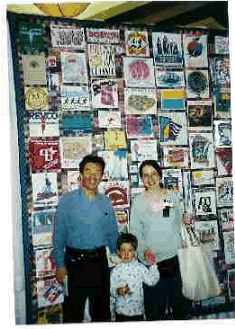
This kind of quilt can be the ultimate bar or bat mitzvah present, graduation present, memory quilt or even chuppah. There's just one problem: Tee shirts and other garments must be tamed before they will play nicely in a quilt.
I evolved the this approach when my friend Takashi, right, and his wife, shlepped two large cartons, containing 75 of his marathon tee shirts, into my playroom, and asked me to turn them into one quilt. (If I'd used a 14" rectangle from each, we would have had a loose-fitting termite tent for the Hearst Castle).
I call my approach "free-range," because, unlike most tee-shirt quilt patterns, it doesn't require that each garment piece be cut to the exact same size. It's "gonzo" because you make it up as you go along. It's "mondo" because it lets you use dozens of tee shirts in one bed quilt (Conventional tee-shirt quilts usually include no more than a dozen.)
The basic idea: Cut closely around each logo, to a square or rectangle that accomodates it nicely. Fuse the rectangle to fusible interfacing. Decide on tee placement, in columns, in the quilt. Add narrow strips of quilters' cotton surrounding the blocks, as needed to equalize the pieces and fit them all together. This approach works for making a quilt from almost any garments or fabrics that can be ironed at a moderate heat.
That's just how I like to work. There are many different approaches to constructing them, which differ from my procedure above. For example,
- Some people cut each shirt to the exact same size. Then they may surround the garment with borders and sashing made from quilting (or other) fabric. I'm not wild about this approach, because tee shirt logos vary wildly in size, and so some of the tee blocks will look empty, while others will look squeezed into the standard size.This approach doesn't allow for small logos that you might want to add.
- There's a more math intensive a approach in the book 'How to Make a Too Cool T-Shirt Quilt," by Andrea Funk, http://www.toocooltshirtquilts.com/. The square roots allow pieces of many sizes to fit together like a jigsaw puzzle, with no additional fabric needed. Andrea also doesn't use fusible interfacing - while I think the fusible is essential to tame knits. And she wants you to order a set of custom-made acrylic templates in the various sizes that will be in the quilt. It's a little more trouble than I want to go through, but your mileage may vary! Whether or not you use her approach, the book is full of helpful ideas on an array of related subjects, including dealing with garments other than standard tee shirts, like tank tops, towels, boxer shorts, baby outfits, etc.


